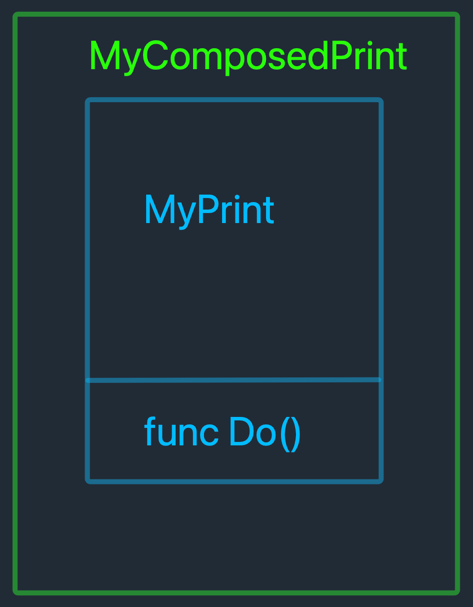What is method overriding?
Method overriding is a feature of object-oriented programming languages that allows a subclass to provide a specific implementation of a method already defined in its superclass. When a subclass overrides a method, the subclass’s method is called instead of the superclass’s method when the object is of the subclass type. Method overriding is an example of polymorphism, where the same method name can have different implementations depending on the object’s type.
Go does not have classes, but it has structs and interfaces that can be used to achieve similar functionality.
Embedded structs
Go favors composition over inheritance. Multiple smaller types can be combined to create a larger type. A clean way to do this is through embedded structs. When a struct embeds another struct, it inherits the embedded struct’s fields and methods. For example, consider the following code:
package main
import "fmt"
type MyPrint struct {
i int
}
func (m* MyPrint) Do() {
fmt.Printf("Hello, World! %d\n", m.i)
m.i++
}
type MyComposedPrint struct {
MyPrint
}
func main() {
fmt.Println("Base:")
var m MyPrint
m.Do()
m.Do()
fmt.Println("Composed:")
var s MyComposedPrint
s.Do()
s.Do()
}
This code outputs the following when run:
Base:
Hello, World! 0
Hello, World! 1
Composed:
Hello, World! 0
Hello, World! 1
The composed struct forwards the method call to the embedded struct.

Method overriding with embedded structs
To override a method in Go, you can define a method with the same name and parameters in the composed struct. For example, consider the following code:
package main
import "fmt"
type MyPrint struct {
i int
}
func (m* MyPrint) Do() {
fmt.Printf("Hello, World! %d\n", m.i)
m.i++
}
type MyComposedPrint struct {
MyPrint
}
func (m*MyComposedPrint) Do() {
// call the parent method, similar to super.Do() in other languages
m.MyPrint.Do()
fmt.Printf("Hello, Composed World! %d\n", m.i)
m.i++
}
func main() {
fmt.Println("Base:")
var m MyPrint
m.Do()
m.Do()
fmt.Println("Composed:")
var s MyComposedPrint
s.Do()
s.Do()
}
This code outputs the following when run:
Base:
Hello, World! 0
Hello, World! 1
Composed:
Hello, World! 0
Hello, Composed World! 1
Hello, World! 2
Hello, Composed World! 3
MyComposedPrint.Do overrides MyPrint.Do. When deciding which method to call, Go first looks for the method in the
type itself. If the method is not found, Go looks for the method in the embedded types.
Method overriding and interfaces
Method overriding is often used in conjunction with interfaces. An interface defines a set of methods a type must implement to satisfy the interface. When a type implements an interface, it can be used wherever the interface is expected. An interface is another example of polymorphism in Go.
One typical pattern is overriding a method in a 3rd party library. For example, you can embed a type from a library and override a method to add additional functionality. However, you will still pass the new type in your code using the library’s original interface.
Further reading
- We recently described the differences between Go modules and packages.
- Previously, we explained how to properly unmarshal JSON null, set, and missing fields in Go.
- We also explained the difference between nil slice and empty slice in Go.
Watch method overriding in Go video
Note: If you want to comment on this article, please do so on the YouTube video.
